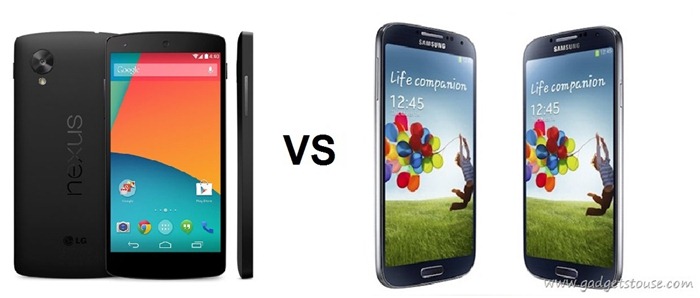Weight and Body Design
Nexus 5 dimensions: 137.9 x 69.2 x 8.6 mm, weight: 130g Galaxy S4 dimensions: 136.6 x 69.8 x 7.9 mm, weight: 130g The Nexus 5 is the thicker on of the two, but apart from thickness you won’t be able to feel any difference in dimensions when either device is held in your hands. Both devices aren’t too big, and based on my experience with the Galaxy S4 while keeping in mind the dimensions of the Nexus 5, I can say that the Nexus 5 would fit most hands well.
Display and Processor
Both devices come with 5 inch displays (Nexus 5 has a 4.95 inch screen, the 0.05 inch difference can be safely neglected) which pack a full HD resolution of 1920×1080 pixels. While the Galaxy S4 packs a pixel density of 441ppi, the Nexus 5 churns out a negligibly greater 445ppi thanks to the slightly smaller display. While the Nexus 5 uses IPS panels, the Galaxy S4 comes with the trademark Samsung Super AMOLED. Both technologies have their own pros and cons. While the Super AMOLED panel on the S4 will accentuate and sometimes over-saturate the picture, it’ll come with better power management. On the other hand, the IPS panel on the Nexus will provide great viewing angles. The Nexus 5 features Qualcomm’s Snapdraon 800, featuring a quad core 2.3GHz CPU making it one among the most powerful mobile processors. Giving neck-to-neck competition to this is Samsung’s Exynos 5410, which comes with 2 sets of quad core CPUs, one clocked 1.6GHz (Cortex A15) and the other, 1.2GHz (Cortex A7). The chipset automatically switches between these sets of cores depending upon the processing power that’s required. However, neither beats the Qualcomm Snapdragon 800, which should beat the Exynos 5410 in most departments.
Camera and Memory
We haven’t physically tested the Nexus 5’s shooter yet, but are very inclined to believe in the claims made by Google about the 8MP OIS camera on the phone. In pure megapixel terms, the Galaxy S4’s 13MP sounds way better than the 8MP used on the Nexus 5. However, the Nexus 5 offers some new-age tech like OIS (Optical Image Stabilization) which promises to make the picture blur free. On the other hand, the Galaxy S4 comes with a tried and tested 13MP unit, which does neutral shots which are, upto an extent, very life-like. The Nexus 5 comes in 16/32GB variants, while the Galaxy S4 does an additional 64GB variant. Plus, the Nexus 5, like its younger siblings, does not feature a microSD slot for expansion while the S4 does, which means the S4 is your choice if you are looking for a device with expandable storage.
Battery and Features
The S4 comes with a 2600mAh battery, while the Nexus 5 features a smaller 2300mAh unit. However, the Nexus 5 has the Snapdragon 800 chipset which boasts better power management, which should be able to bridge the gap of 300mAh between the two batteries. One full day of backup on both devices with moderate usage should be achieved by most users, which means we can’t pick one out of the two. However, the S4 will have greater standby hours. The S4 features gesture controls which don’t come with the Nexus 5. As gimmicky as they may seem, it is our duty to make you aware of them and we did.
Key Specs
Conclusion
While the S4 does very well to stay in the competition despite being the older device of the two, we have to say that the Nexus 5 will be our obvious choice. Reasons being – Snapdragon 800, direct Google support, lower cost, etc. And for the first time, the phone will be available via an official Google chain! However, you might have to do with low storage space on the phone since it does not feature a microSD card slot. Other than that, the phone is the outright winner!
